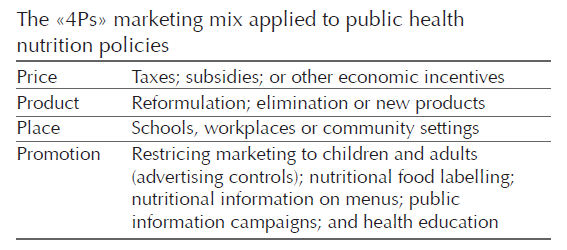Assessing public health nutrition policies across 30 European countries using the marketing “4Ps” approach
Countries across Europe have introduced a wide variety of policies to improve nutrition. However, the sheer diversity of interventions represents a potentially bewildering “policy cacophony”, a smorgasbord which is difficult to comprehend, categorise or evaluate. The aim of this study was to map existing public health nutrition policies, and examine their perceived effectiveness, in order to inform future evidence-based diet strategies.
To achieve that, a public health nutrition policy database for 30 European countries was created and classified using the marketing “4Ps” approach: PRODUCT / PRICE/ PROMOTION / PLACE. Our study draws from interviews with 71 senior policy-makers, public health nutrition policy experts and academics from 14 of the 30 countries, eliciting their views on diverse current and possible nutrition strategies.

Reformulation of food PRODUCTS: mandatory and voluntary initiatives
Thirteen countries have legal requirements regarding the maximum salt content in certain food (Belgium, Bulgaria, Finland, Greece, Hungary, Latvia, Lithuania, Netherlands, Portugal, Romania, Slovak republic, Slovenia and Wales). Four countries have effective trans fats bans (Denmark, Austria, Iceland and Switzerland). Legislation or regulation affecting sugar, fat and fruit and vegetable consumption was uncommon: only 4 countries (Finland, France and Latvia for sugary products; Latvia for fat and sugary foods; and Slovakia for Fruit and Vegetables).
Many participants commented that the mandatory reformulation of food products was perceived as an effective and cost-effective approach for improving public health nutrition. It was perceived as acceptable to the food industry and the public alike.
Voluntary reformulation of foods by the food industry was common, occurring in 25 of the 30 countries, most commonly for salt. Estonia, France and the Netherlands have voluntary reformulation in relation to sugary foods and total fat.
PRICE: Taxes & subsidies as effective options
Price incentives in different European countries targeted various unhealthy nutrients, including salt, sugar and saturated fat. Taxes to promote healthy nutrition (e.g. fruit and vegetables) are currently only used by six countries. Finland, France, Hungary and Latvia have implemented ‘sugar taxes’ on sugary foods and sugar-sweetened beverages, while Portugal is the only country that taxes salty products. Hungary taxes food high in fat.
The majority of interview respondents felt that “Price” incentives such as taxes, legislation and regulation were the most effective options for improving public health nutrition. At this point of time, subsidises for healthy food products were uncommon, apart from the almost universal EU School Fruit Subsidy Scheme. Co-funded by the EU and individual Member States, this voluntary scheme aimed to encourage good eating habits in young people by making fruit and vegetables available to children in schools.
PROMOTION & advertising controls
Information campaigns targeted at the general population were widespread. The majority focused upon general healthy eating messages and/or campaigns targeted at reducing childhood obesity.
Some countries also highlighted specific nutritional topics such as salt (e.g. Belgium, England, Estonia, Ireland, Italy, and Slovenia). However, participants generally perceived such interventions to have limited impact.
Many countries include nutrition education as a mandatory part of the school curriculum and most are also actively improving the nutritional value of foods available in schools. Moreover, food labelling of nutritional composition is also common, but presentation and information varied widely.
In terms of marketing of foods high in fat, salt and sugar to children, many of the 30 countries were self-regulating, with 12 countries having mandatory regulations against marketing to children. Interviewees perceived mandatory measures around marketing of foods high in fat, salt and sugar as clearly being more effective than self-regulation.
PLACE: Schools as a key target
Place interventions aim to modify food quality or availability in specific settings. The majority were situated in schools and, to a lesser extent, workplaces. Interventions primarily focused on the removal of vending machines, or replacing the contents of vending machines, and legislation, regulation or recommendations on food offered in canteens. Many countries are actively improving the nutritional value of foods available in schools. Participants felt that interventions targeted in school settings or preschool (kindergarten) settings were effective.
CONCLUSIONS
Public health nutrition policies in Europe appear diverse, dynamic, complex and possibly bewildering. The «4Ps» framework potentially offers a structured and comprehensive categorisation. Encouragingly, the majority of European countries are engaged in activities intended to increase consumption of healthy food and decrease the intake of «junk» food and sugary drinks. Leading countries include Finland, Norway, Iceland, Denmark, Hungary, Portugal and perhaps the UK. However, all countries fall short of optimal activities. More needs to be done across Europe to implement the most potentially powerful fiscal and regulatory nutrition policies.
